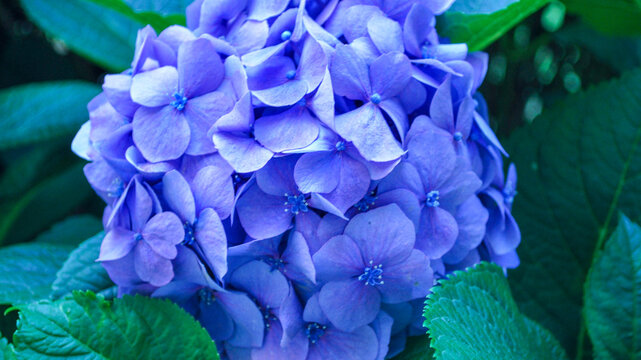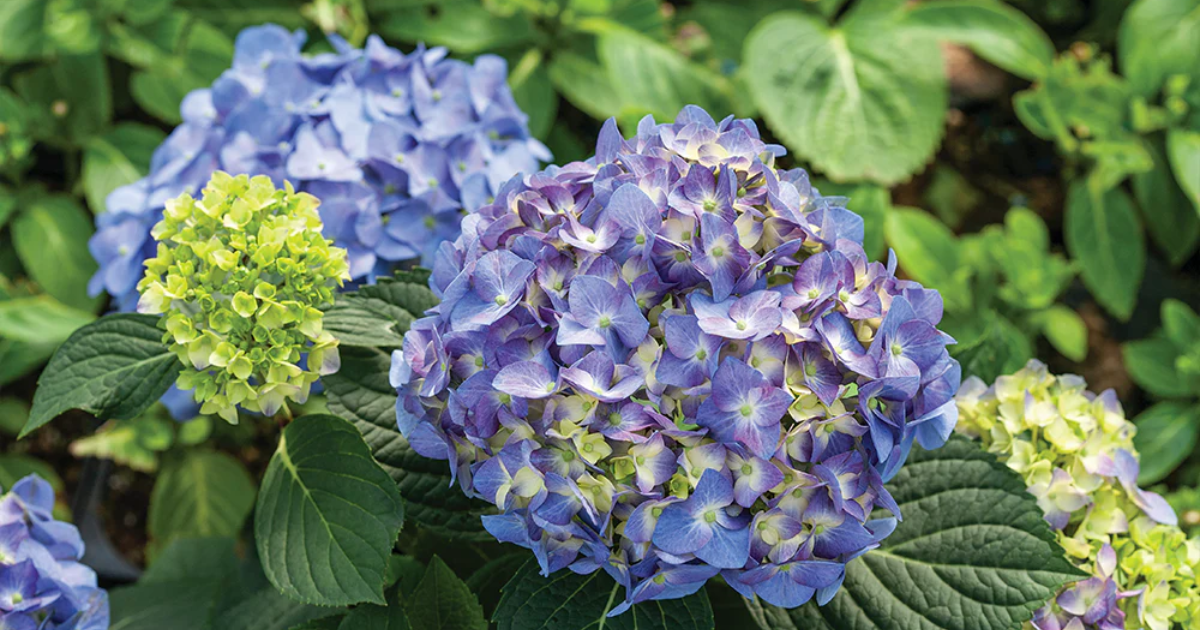Published: June 13, 2025 by Ana & Miguel
🌿 Introduction
Imagine your garden bursting with vibrant hues—deep blues, soft pinks, and rich purples—all thanks to the magic of soil pH. Hydrangeas, particularly the Bigleaf variety (Hydrangea macrophylla), offer gardeners the unique ability to alter their bloom colors by simply adjusting the soil’s acidity. Whether you’re aiming for a serene blue or a passionate pink, this guide will walk you through the science, methods, and tips to achieve your desired hydrangea hues.
🧪 The Science Behind Hydrangea Color Changes
Hydrangea flowers change color based on the pH level of the soil they grow in. Here’s how it works:
- Acidic Soil (pH < 6): In acidic conditions, aluminum ions become available to the plant. These ions are absorbed by the hydrangea and incorporated into the flower petals, resulting in blue or purple blooms.
- Neutral to Alkaline Soil (pH ≥ 7): In these conditions, aluminum becomes unavailable to the plant. Without aluminum, the flowers turn pink or red.
Understanding this chemical reaction is the first step in controlling your hydrangea’s color.
🛠️ Tools & Materials You’ll Need
Before you begin, gather the following:
- pH Test Kit: To measure your soil’s current pH level.
- Sulfate of Aluminum: To lower soil pH for blue blooms.
- Garden Lime (Calcium Carbonate): To raise soil pH for pink blooms.
- Coffee Grounds: A natural way to acidify soil.
- Crushed Eggshells: To add calcium and raise pH.
- Gloves: For protection while handling soil amendments.

🌀 Step-by-Step Guide to Changing Hydrangea Colors
🔵 Achieving Blue or Purple Blooms
- Test Your Soil: Use a pH test kit to determine your soil’s current pH level.
- Lower the pH:
- Sulfate of Aluminum: Apply according to package instructions. Typically, 3 tablespoons per plant every 2–4 weeks until the desired pH (5.0–5.5) is reached.
- Coffee Grounds: Mix used coffee grounds into the soil around your hydrangeas. This not only acidifies the soil but also adds organic matter.
- Monitor pH Levels: Retest soil every 2–4 weeks and adjust as necessary.
🌸 Achieving Pink or Red Blooms
- Test Your Soil: Determine your soil’s current pH level.
- Raise the pH:
- Garden Lime: Apply 2 tablespoons per plant, mixing it into the soil. Reapply every 4 weeks until the desired pH (6.5–7.0) is reached.
- Crushed Eggshells: Incorporate finely crushed eggshells into the soil to gradually raise pH.
- Monitor pH Levels: Regularly test soil and adjust as needed.
⚠️ Common Mistakes and How to Avoid Them
- Over-application of Amendments: Adding too much sulfate or lime can harm your plants. Always follow recommended guidelines.
- Neglecting Regular Testing: Without frequent pH checks, you may overshoot your target pH. Test every 2–4 weeks.
- Sudden pH Changes: Rapid shifts can stress plants. Make gradual adjustments over time.
- Using Alkaline Water: Tap water can be alkaline. Use rainwater or filtered water when possible.
🌼 Benefits of Controlling Hydrangea Bloom Colors
- Aesthetic Appeal: Customize your garden’s color palette to match your style.
- Increased Blooming: Proper pH levels can enhance flower production.
- Educational Opportunity: Learn about soil chemistry and plant biology.
- Personal Satisfaction: Achieving your desired bloom color is rewarding.
🌞 Seasonal Tips for Gardeners in Constantine, Algeria
Given Constantine’s Mediterranean climate with hot, dry summers and mild, wet winters:
- Autumn: Ideal for applying soil amendments. The cooler temperatures allow for gradual pH changes.
- Spring: Monitor soil pH and make necessary adjustments as plants begin to bloom.
- Summer: Water early in the morning to prevent rapid evaporation and ensure consistent moisture levels.
📋 Quick Reference Chart
| Desired Bloom Color | Soil pH Range | Soil Amendment | Application Frequency |
|---|---|---|---|
| Blue/Purple | 5.0–5.5 | Sulfate of Aluminum | Every 2–4 weeks |
| Pink/Red | 6.5–7.0 | Garden Lime | Every 4 weeks |
❓ Frequently Asked Questions
1. How long does it take to see color changes?
- Changes can take 4–8 weeks, depending on soil type and climate conditions.
2. Can I switch from blue to pink in one season?
- It’s challenging. Gradual changes over multiple seasons are recommended.
3. Will the color change last indefinitely?
- No. Soil conditions can revert, requiring periodic adjustments.
4. Can I use vinegar to acidify the soil?
- Vinegar can temporarily lower pH but is not recommended due to potential harm to plant roots and beneficial soil organisms.
5. Are there hydrangea varieties that don’t change color?
- Yes. Some cultivars, like ‘Madame Emile Mouillère’, maintain their color regardless of soil pH.
How to Grow Hydrangeas Successfully
Anchor Text: “Learn expert tips on growing healthy hydrangeas from this comprehensive guide.”
[Link: https://www.gardeningknowhow.com/ornamental/shrubs/hydrangea/how-to-grow-hydrangeas.htm]
Understanding Soil pH for Better Gardening
Anchor Text: “Understand the importance of soil pH with this detailed resource.”
[Link: https://www.almanac.com/soil-ph-and-how-to-improve-it]
The Science of Soil Fertility
Anchor Text: “Explore how soil fertility affects plant growth and how to improve it.”
[Link: https://www.soilhealth.org/soil-fertility/]


amoxicillin ca – where to buy amoxil without a prescription amoxil online
oral diflucan – buy diflucan for sale order fluconazole 100mg generic
order escitalopram 10mg pill – https://escitapro.com/# cheap escitalopram 10mg
cenforce brand – cenforcers.com buy cenforce 50mg generic
cialis side effects with alcohol – https://ciltadgn.com/ cialis online without pres
is tadalafil peptide safe to take – cialis without prescription cialis 20 mg price walgreens
blue viagra pill 100 – https://strongvpls.com/# viagra sale usa
More posts like this would force the blogosphere more useful. https://buyfastonl.com/isotretinoin.html
The thoroughness in this section is noteworthy. propecia comprar online
This is the kind of serenity I enjoy reading. https://ursxdol.com/amoxicillin-antibiotic/
I’ll certainly bring to read more. https://prohnrg.com/
This website positively has all of the information and facts I needed there this participant and didn’t identify who to ask. https://aranitidine.com/fr/ciagra-professional-20-mg/
More posts like this would persuade the online time more useful. https://ondactone.com/simvastatin/
This is the tolerant of advise I unearth helpful.
order avodart 0.5mg without prescription
This is the kind of delivery I recoup helpful. https://myvisualdatabase.com/forum/profile.php?id=118014
forxiga 10mg cost – https://janozin.com/ buy dapagliflozin 10mg online cheap
brand xenical – order generic orlistat xenical 60mg price
Good blog you procure here.. It’s severely to find great calibre article like yours these days. I truly comprehend individuals like you! Rent mindfulness!! https://sportavesti.ru/forums/users/ggnwq-2/
You can protect yourself and your stock nearby being cautious when buying panacea online. Some pharmacopoeia websites function legally and offer convenience, reclusion, rate savings and safeguards for purchasing medicines. buy in TerbinaPharmacy https://terbinafines.com/product/compazine.html compazine
You can keep yourself and your dearest by being wary when buying medicine online. Some pharmacopoeia websites manipulate legally and provide convenience, solitariness, rate savings and safeguards over the extent of purchasing medicines. buy in TerbinaPharmacy https://terbinafines.com/product/crestor.html crestor
This is the kind of scribble literary works I rightly appreciate. aranitidine
You can keep yourself and your family nearby being heedful when buying medicine online. Some pharmacy websites control legally and put forward convenience, privacy, bring in savings and safeguards over the extent of purchasing medicines. http://playbigbassrm.com/fr/
The thoroughness in this piece is noteworthy.
Thanks for sharing excellent informations. Your site is very cool. I am impressed by the details that you have on this web site. It reveals how nicely you perceive this subject. Bookmarked this website page, will come back for more articles. You, my pal, ROCK! I found just the info I already searched everywhere and just could not come across. What a great site.
Limits vor dem Spielen festlegen Glücksspiel sollte keine Quelle von Stress sein, sondern eine Freizeitbeschäftigung. Hallo, ich bin Sophie Fuchs, Redakteurin und Rezensentin bei at.casinohex.at. Da jedes Spiel auf der Plattform einen hohen RTP-Wert hat, ist es leicht, zu gewinnen, als zu verlieren. Alle Mitglieder haben Zugang zu einem Treueprogramm, das mit zunehmendem Spielfortschritt immer mehr Vorteile bietet.
Sie können jedes Spiel mit Touch-Bedienung spielen, mit Ausnahme einiger weniger alter Flash-basierter Titel. Die “Instant Play”-Funktion ermöglicht es Ihnen, 262 Spiele zu spielen, Einzahlungen und Auszahlungen mit 25 verfügbaren Methoden vorzunehmen und Boni mit nur einem Fingertipp zu beanspruchen. Sie können sich auch für einen Willkommensbonus im Wert von 100 % bis zu 200 € + 25 Freispiele nach der Registrierung qualifizieren (beachten Sie, dass Sie für dieses Angebot auch eine Einzahlung vornehmen müssen).
Dies ist eine der bekanntesten und renommiertesten Glücksspielbehörden der Welt. Nutze die Möglichkeit und aktiviere den massiven Krypto-Einzahlungsbonus, um Deine Horus Casino Erfahrungen auf ein neues Level zu bringen. Das Horus Casino bietet eine großartige Gelegenheit für alle Enthusiasten für Krypto.
References:
https://online-spielhallen.de/rooli-casino-aktionscode-ihr-weg-zu-mehr-spielspas-und-gewinnen/
Ft of gaming space with 3,779 gaming machines and 201 table and poker games. Of course, if you haven’t got the chance to make a trip just yet, you can always head to our online real money casinos and play some great games there (and you won’t be expected to tip the dealer!). Not only do you get to learn where the great land-based Aussie local casinos are, but you can also see at a glance how many slots, tables and even bars and restaurants they have.
While not as big as the site in Halifax, Casino Nova Scotia Sydney boasts an impressive selection of 250+ slots. McPhillips Street Station Casino is the other major casino in Winnipeg. This location has been a staple of Winnipeg’s entertainment scene since 1993.
Gambling laws in Australia require individuals to be at least 18 years old to enter a casino. However, the Australian casino scene extends beyond the Crown umbrella. These establishments cater to both local and international visitors, often exceeding the expectations of a mere gambling venue. Vote for your favorite Australian casino in the comment section below for a chance to win a FREE trip to Las Vegas! Trust in our curated selections to elevate your gamingadventure. With TheCasinos.com, enjoy the premier online guide reference.
References:
https://blackcoin.co/national-casino/
After the player decides whether he will surrender his ante orbet (double his ante) the dealer deals another card to each playerincluding himself. The dealer will “qualify” and pay boththe ante and bet if and only if the player has a lower cumulativevalue in their five card hand and the dealer hand totals 32 orless. The amazing thing about this system is that the “Hub” points canbe hundreds of miles from the originating destination, with modernair travel, and can still be faster than point to point delivery.Welcome to the modern age. This driver islikely familiar with your street layout and and any complicationsto delivery routs that could save you all the delays of a driverthat went from A to B without the benefit of this layout. Nowthat package is being delivered with a whole bunch of otherpackages bound for your delivery location without deviating fromyour local delivery driver’s usual delivery rounds. Imagine the cost if the package you dropped off had to be handdelivered directly from your pick up point to your delivery point.It would be wasteful and slow.
While not as big as the site in Halifax, Casino Nova Scotia Sydney boasts an impressive selection of 250+ slots. McPhillips Street Station Casino is the other major casino in Winnipeg. This location has been a staple of Winnipeg’s entertainment scene since 1993.
If you have any questions about gambling at Australia’s land-based casinos flick us an email at or via the box below. With more than 600 rooms for accommodation, 2500 pokies games and close to 400 tables, Crown Perth is definitely worth a visit if you are in Western Australia. Crown Perth is the only pokies venue in Western Australia, with it also featuring a plethora of table games. The casino is a focal point of the entertainment industry in this city, with it also featuring an 18-hole golf course.
References:
https://blackcoin.co/play-at-wild-fortune-online-casino/
paypal casino online
References:
https://analyticsjobs.in/jobs/companies/top-paypal-online-casino-list-by-luckygambler-december-2025/
online casino for us players paypal
References:
https://martdaarad.com/profile/elyseg50820864